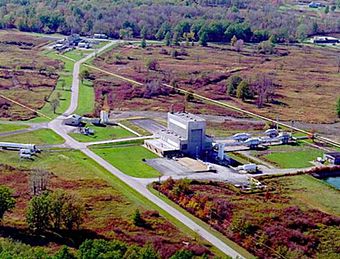Spacecraft Propulsion Research Facility facts for kids
Quick facts for kids |
|
|
Spacecraft Propulsion Research Facility (B-2)
|
|

Facility aerial view
|
|
| Location | Erie County, Ohio |
|---|---|
| Area | less than one acre |
| Built | 1968 |
| Architect | NASA |
| NRHP reference No. | 85002802 |
| Added to NRHP | October 3, 1985 |
The Spacecraft Propulsion Research Facility is a special place where scientists test rocket engines. It's now called the In-Space Propulsion Facility. NASA says it's the "world’s only facility" that can test large rocket parts and engines. It can even test them as if they were high up in space!
This amazing facility is located at NASA's Plum Brook Station. This is near Sandusky, Ohio. It was built in 1968. One of its first big jobs was testing parts of the Centaur Rocket. Centaur rockets helped launch some of America's most important space missions. Because it's so important, the facility was named a National Historic Landmark in 1985.
What is the In-Space Propulsion Facility?
The Plum Brook Station is a large, remote area. NASA chose this spot to safely test big, powerful equipment. The In-Space Propulsion Facility is one of several buildings there. It was designed to test-fire large rockets.
Inside the Test Chamber
The facility has a main building with a huge test chamber. There's also a building for test equipment. Plus, it has special areas for rocket fuel and exhaust. The main chamber is a giant steel cylinder. It can hold rocket parts up to 22 feet (6.7 m) wide and 50 feet (15 m) tall. That's like fitting a small house inside!
A huge door, 27 feet (8.2 m) high, lets equipment into the chamber. Scientists can watch tests through special windows. The chamber has a cooling wall that gets super cold, about −320 °F (−195.6 °C). This is done using liquid nitrogen. Infrared lamps inside the chamber can make it feel like the heat from the sun in space. The air pressure inside can also be lowered. This makes it feel like you are 100 miles (160 km) high in space. Rockets tested here can create a thrust of up to 400,000 pounds. That's a lot of power!
Testing Rockets for Space Missions
This facility was built in 1968. It was a key part of developing the Centaur rocket. These rockets are called "upper-stage" rockets. They are launched on top of bigger rockets, like the Atlas V. They need to fire high up in the atmosphere. This helps them push their payloads out of Earth's orbit.
More than ten tests of Centaur rockets happened here. These tests helped make sure the rockets worked perfectly. Thanks to this facility, missions like the Pioneer, Voyager, and Viking programs were successful. These missions sent probes to explore distant planets.



